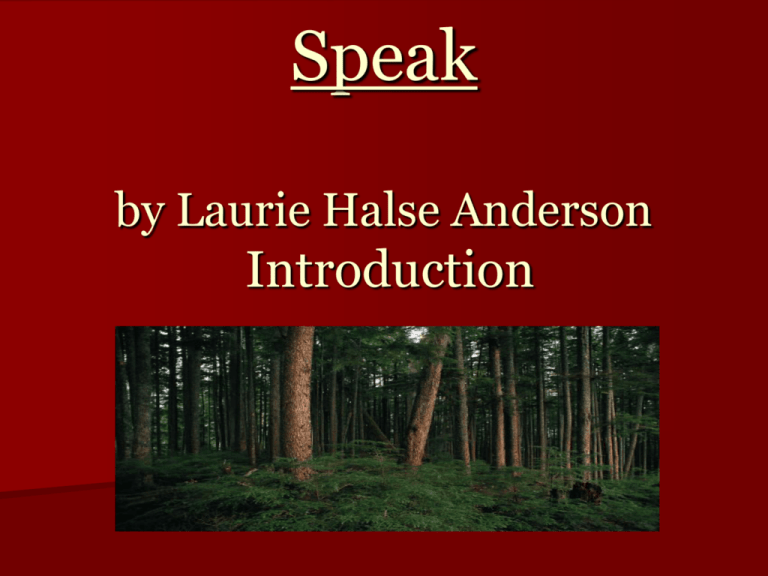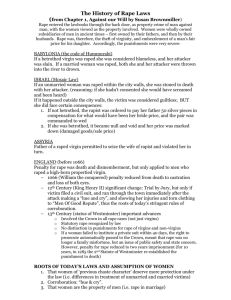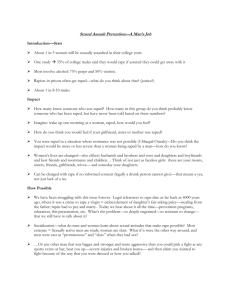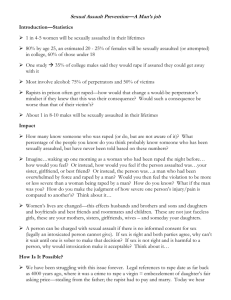
Speak
by Laurie Halse Anderson
Introduction
What is the Definition of Rape?
Rape is defined as sexual penetration
without consent where there is force or
coercion.
Rape is not limited to only genital
intercourse.
ANSWERS: ‘Date rape – true or false?’
1. True – a staggering 90% of people are raped by someone they know.
2. False – rape includes many other sexual acts (e.g. oral sex, unwanted
touching).
3. False – it can happen in longer-term relationships as well, or be committed
by people you’ve known for a long time (e.g. a friend of the family).
4. False – both partners need agree to have sex together. Also, a girl shouldn’t
have to be the one who says no – and guys can say no too.
5. True – it’s entirely possible and does happen. Just because you’re going out
with someone doesn’t mean they can have sex with you against your will.
6. False – it happens to guys as well. It is thought that about 5% of all date
rape happens to guys.
7. False – Telling someone is a normal thing to do, and nobody gets a bad
reputation for being raped.
8. True – Of course it is. Sex is natural and being sexy is fine. Getting the
wrong message and raping someone is not.
9. False – It’s easy and natural to get aroused by someone else, but it’s
controllable. It is no excuse for raping someone.
10. True – It’s hard enough for many girls to be confident enough to say no in
the first place. If they say it, they really do mean it.
Answers
11. False – No matter how long you’ve been in a relationship with someone it’s
never OK to be pressured into having sex against your will.
12. False – Nobody gets over rape quickly, but there are many ways to deal
with it over time.
13. False – If sex is against one’s will, it is rape. Wearing a condom or not
makes no difference.
14. True – Slipping drugs into drinks does happen but it’s rare compared to
adding extra alcohol or giving someone more drinks than they realise.
15. False – She doesn’t owe him sex at all. If the dinner went well, then things
may develop or they may not, but whatever happens must be with the
agreement of both people.
Your score
1-4. You need to wake up.
5-8. You’ve got an idea but you should get more informed.
9-12. Not bad. Keep learning.
13-15. Excellent. You obviously keep your eyes open.
Answers to the Date Rape Quiz
1. true – “passion” means anger & aggression
2. false – it is about control and aggression
3. false – although the incidents are more
common when alcohol is involved
4. false
5. false
6. false
7. true
8. false
9. false
10. false
True
12. False
13. True
14. True
15. True
16. False
17. True
18. False
19. False
20. False
21. False
22. False
23. False
24. False
11.
Sexual Assault Statistics
Teenage Rape
* 38% of women who have been raped were 14-17 years old at the
time of the attack
* Nearly all female teenage victims know their attacker
* 56% of teenage girls who are raped are raped by a date
* 30% of teenage girls who are raped are raped by a friend
* 11% of teenage girls who are raped are raped by a boyfriend
* 78% of teenage victims do not tell their parents about the
incident
* 71% of teenage victims tell a friend that they were raped
* 6% of teenage rape victims report the assault to the police
* 75% of acquaintance rapes involve alcohol
* 3.3 million Americans aged 14-17 are considered problem drinkers
* The risk of rape is four times higher for women aged 16-24 than
for any other age group
Rape on College Campuses
Incidence facts:
* One in four college women surveyed are victims of
rape or attempted rape
* 85% of rapes on campus are acquaintance rapes
* One in six female college students reported having
been a victim of rape or attempted rape during the
preceeding year
* 27% of women have experienced a rape or attempted
rape since age 14
* The majority of reported victims and offenders are
college age, with the rape victimization highest among
16-19 year olds
Women's responses to assault
facts:
* Only 27% of the women whose sexual
assault met the legal definition of rape
thought of themselves as rape victims
* 42% of college women who are raped
tell no one about their assault
* 42% of the women who were raped said
they had sex again with the men who
assaulted them
* 42% of raped women said they expect
to be raped again
Men's responses to rape facts:
* 84% of college men who committed rape said
that what they did was definitely not rape
* 55% of the men who raped said they had sex
again with their victims
* One in fifteen male students reported
committing a rape or attempting to commit rape
during the preceeding year
* Nearly one third of college men said they were
likely to have sex with an unwilling partner if
they thought they could get away with it
THE FACTS:
Reporting facts:
* 5% of college women who are raped report the rape
to the police
* 5% of college women who are raped seek help at a
rape crisis center
Alcohol facts:
* 90% of acquaintance rapes involve alcohol
* Alcohol is a factor in 100% of gang rapes
Diseases, pregnancy, etc.:
* Three in 1000 college students are HIV-positive
* Every year, one million teenage girls get pregnant
Rapist Profiles
Power-assertive rapist: Athletic, has a "macho" image of
himself. More often than not, this is the type who
commits date rapes. He typically meets his victim in a
bar or nightclub. Instead of targeting a specific victim,
he looks for an opportunity to get a woman alone with
him, perhaps with an offer of a ride home or an
invitation back to his place. Or he may con his victim
into trusting him or letting him into her home, perhaps
by posing as a policeman or repairman. Approximately
44 percent of rapes are committed by power-assertive
rapists. He is physically aggressive, and will use the
amount of force needed to control you -- degrading or
obscene language, [brandishing] a weapon, slapping or
punching -- but he does not intend to kill you.
Generally, begging and crying doesn't work with this
guy. If you're going to resist, you've got to be serious.
You've got to scream and fight him as hard as you can
to get away.
Rapist Profiles
Anger-retaliatory rapist: He feels animosity towards
women and wants to punish and degrade them. Often
he is a substance abuser. He is impulsive and has an
explosive temper. He looks for an opportunity to commit
the rape rather than for a specific victim. He attacks
spontaneously and brutalizes the woman into
submission. Thirty percent of rapists fall into the angerretaliation category. He will grab you from behind and
drag you into the bushes. He will often beat you to nearunconsciousness before committing the rape. Any level
of resistance may well enrage him and cause him to beat
the life out of you until he gets what he wants. He's not
looking to kill you, but the beating could be fatal. You do
not want to challenge or enrage this type of rapist. You
could try to escape. If you cannot get away or
incapacitate the assailant, it's best to submit and try to
limit the level of violence of the assault to the extent
that you can.
Rapist Profiles
Power-reassurance rapist: He lacks the self-confidence and
interpersonal skills to develop relationships with women. He is
passive and nonathletic. He lives or works near his victim, and
"preselects" her by peeping or stalking. He typically breaks into her
home in the early hours of the morning and awakens her. He uses
minimal force and will threaten her with a weapon, but usually does
not have one. He fantasizes that he is his victim's lover so he may
ask her to disrobe or to wear a negligee and he will kiss her and
engage in foreplay. The power-reassurance type accounts for 21
percent of rapists. He is the least violent type of rapist, and does
not intend to hurt or kill you, Among the different types of rapists,
he is most likely to be dissuaded if you scream, cry, plead or fight."
In general it is more probable that you can discourage a rapist who
uses this [power reassurance] approach. But you could instead be
dealing with a power assertive rapist who is starting off with a
softer approach. Try nonviolent tactics, crying, pleading, praying
aloud while you're sizing up the assailant. If it works you may be
able to escape the situation. But if he responds by becoming
verbally abusive or degrading, he is likely a power assertive rapist
and you will have to evaluate whether you are capable of fighting
him off.
Rapist Profiles
Anger-excitation rapist: A sadist, who derives sexual
gratification from inflicting pain. He is typically charming
and intelligent. The crime is premeditated and rehearsed
methodically in his mind before it is attempted. His
victims may or may not be strangers. He will tie, gag
and blindfold them and torture them over a period of
days, even recording his crimes in a diary, taking
photographs or videotaping them. Just five percent of
rapists fit this description.
Of the four types he is the most criminally sophisticated
and it's difficult to catch him. He's got absolute control
over you so there's no question of any type of resistance
or of escaping. Oftentimes he kills his victims, either to
get rid of a witness or to gratify a psychosexual need."
This is probably the most dangerous situation a woman
can be in. If you're tied up, you're going to have to
match wits with this guy and trick him or talk him into
untying you so you have at least some chance of
escape.
Rapists
Most rapists are not murderers. It is less likely that a
woman - even one who has taken a women's selfdefense course -- can overcome the intensity of the
violence that an anger rapist will inflict. But power
rapists commit nearly two-thirds of all rapes, and you
have a fighting chance to fend them off. If you assess
the situation and feel confident of your ability to fight or
talk your way out of [being raped], go ahead and do it.
"Women need to rely on their instincts. When confronted
with a rapist they will try various techniques. In this
situation, take full advantage of your instincts in trying
to figure out which type of rapist you are dealing with".
What You Should Do:
There are women who have yelled or fought
back, whether they've taken self-defense classes
or not, and have not gotten raped. To tell a
woman 'don't do anything, be the passive
female' is absolute (nonsense)."
Given that the goal of all women who are in
imminent danger of being raped is to avoid it,
they should rely on their instincts rather than
assume that they have to submit. But whatever
her instincts tell her to do, If a woman survives,
she made the right choice.
Tips to Avoid Date Rape
STEP 1: Realize that date rape typically occurs when the
couple is alone. Go out in a group with new dates.
STEP 2: Avoid drinking or doing drugs, which could
affect your judgment and make it easier for someone to
take advantage of you.
STEP 3: Be aware of your date intruding on your
personal space. This is a sign that he may not respect
your boundaries.
STEP 4: Be clear with the signals you send out so a
man doesn't have to guess what you mean. Speak up if
you feel things are getting out of hand.
STEP 5: Set sexual limits. It's OK to stop sexual activity
when you've had enough.
Tips to Avoid Date Rape
STEP 6: Examine unconscious messages you may be sending out
that could be putting you at risk. For instance, consider the way you
dress, walk, gesture and talk.
STEP 7: Pay your own way to retain your independence and avoid
a man feeling you "owe him something" in return for your meal.
STEP 8: Trust your instincts. If you feel uncomfortable, remove
yourself from the situation immediately, even if you think you're
being rude.
STEP 9: Always carry taxi fare so you can get yourself home if you
need to.
STEP 10: Avoid going to a man's home or inviting him to yours
until you know him very well.
Tips & Warnings
Remember that there is no excuse for rape. Try to be aware and
minimize your risks as much as you can.
Laurie Halse Anderson
1961-present
She married Gregory H. Anderson June 19, 1983, and the couple
has two daughters.
Anderson’s most noted work is Speak, a book she wrote for teenage
readers. The book tells the story of Melinda, a high school
freshman. Melinda is an outcast at her school and is sexually
assaulted by a senior at a party. The book documents Melinda’s
reactions to the assault and her feelings of isolation and rejection
from those who surround her.
Anderson had the idea to write Speak after awaking from a
nightmare in which she heard a young girl screaming for help. As
Anderson wrote Speak she found it hard to remember that Melinda
was merely a character in the book and not a real person. Anderson
rewrote the ending of Speak three times before she was satisfied
with the story.
Anderson also wrote Fever 1793, which is the story of a teenage
girl’s life during a yellow fever breakout. She has also published
numerous books as part of the “Wild at Heart” series.
Anderson currently resides in Maple Glen, Pennsylvania.







